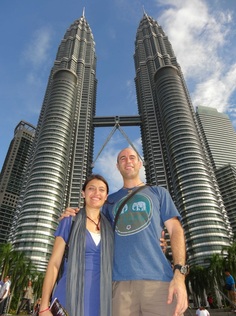
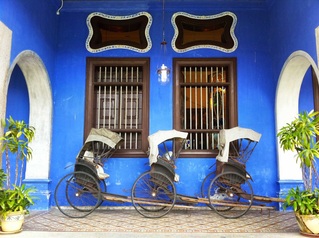
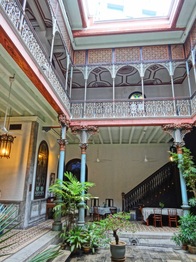
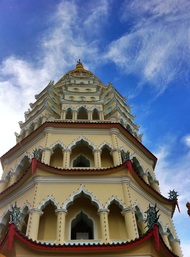
Dim Sum’s roots lay buried in Southern China where the ancient tradition of tea tasting was popular. As the silk road grew more crowded with travelers and people discovered that tea aided in digestion, it made sense to offer some snacks with the tea. Lucky for us, those snacks were so delicious and varied, that the tradition stuck and Dim Sum was born. Literally meaning, “touch the heart”, I think the Chinese may have had some inkling of how unhealthy these little delectable morsels were when they came up with the name – if you’re not moderate they literally will touch your heart! But as we flew into Kuala Lumpur and got our first experiences of the city, we realized that the idea of dim sum really epitomizes the cultural smorgasbord found in the country. In addition to the indigenous Malay population, India and China have both been actively trading with the strategically located peninsula since around the 2nd century AD. By the 11th century Islam had spread across the country via trade and in the 16th century the Dutch established a strong presence, followed finally by the British in the 18th century.  But the highlight of the city came in a pair. The Petronas Towers rise 1,500 meters in the air and seem almost like giant minarets visible from anywhere in the city. The towers are the home of the country’s national oil company, but also incorporate Islamic geometric principles as they rise in the shape of an eight-sided star. Under the towers sits an enormous mall while in their shadow is a large park with a wave pool - a playground for kids. All in all, it’s a wonderfully designed space, perhaps best appreciated from above. To do so, we headed to the nearby Trader’s Skybar, with views straight to the towers and attached park. As day turned to night, we watched the towers light up like shimmering crystals protesting the darkness. The sight of this architecture, turned into mesmerizing, incandescent sculpture as the night fell, was a true highlight. Add to that our first beer in 6 weeks (we didn’t drink while in India) and the night was complete!  Cheong Fatt Tze Mansion After Kuala Lumpur we headed to the Cameron Highlands for adventures with tea (see our post about that here), before heading to the island of Penang, in the northwestern part of the peninsula. Penang’s history started to get really interesting in 1786 when the Sultan of Kedah ceded Penang to the British East India Company in an attempt to gain protection against Siam (though it didn’t work). The British established Penang and other small territories along the coast of Malaysia (called the “Straits Settlements”) to use them as free trade ports. As such, an enormous mixture of people combined there, making a veritable dim sum cart of cultures. There were the indigenous Malays, the Chinese (who had come in droves when tin was discovered in Malaysia), the Klings (southern Indians), and of course the Europeans. In addition, a new culture known as Pernakan was created out of the marriages of Malays and Chinese.  traditional atrium The mixture finds its apex in the delightful city of Georgetown on Penang. Old Chinese shop houses sit across Anglican churches (and a British fort) while Little India booms out music and the local Malays worship at the white-washed mosques. We stayed in a Chinese heritage house, formerly a shop house and family home all in one. It had a beautiful atrium in the middle - a necessity in Chinese Feng Shui, which believes that rain water must be able to enter the home as it symbolizes the coming of wealth. From there, we explored the city and island and its many gustatory delights. Each morning would find us participating in the ritual of dim sum, where a pot of loose leaf Chinese tea was served as women would cart around trays with little dishes of goodies you could choose. Some of our favorites were the deep fried pork rolls, the Chinese white bun stuffed with chicken, egg, and mushroom, and the crab and sesame seed topped dumplings! When we were sated on meat, the city also had a variety of economical vegetarian buffets, where you could fill up your plate with healthy greens and delightful tofu dishes for just a few dollars.  Pagoda of 10k Buddhas After our big breakfasts, we would do some sightseeing before retreating back to our wonderful room for a respite from the smothering heat. The one day we rented a motorbike and braved the heat, however, we did manage to see many of the sites outside of Georgetown. This included Wat Chayamangkalaram, a massive Thai temple with a huge reclining Buddha inside, and Kek Lok Si Temple, the largest Buddhist temple in all of Malaysia. Kek Lok Si sports a massive statue of Kuan Yin (the bodhisattva of compassion) as well as the towering Pagoda of Ten Thousand Buddhas, which was designed in Chinese, Thai, and Burmese styles to represent the unity of the different types of Buddhism. Perhaps most unique however, was Ban Kah Lan, or the snake temple, where many years ago monks had allowed the local venomous Wagler’s pit vipers to live on the grounds rather than kill them. Over time, this developed as the temple’s primary attraction and a visit sees the vipers not only on branches curving next to the altar, but resting on branches all over the trees behind the temple. Be warned that it’s good to visit during the day when the vipers are sleeping – a trip at night may be your last! The Chinese architecture in Georgetown was impressive as well. The Cheong Fatt Tze Mansion showed the opulence enjoyed by one of China’s richest businessmen at the turn of the 20th century. Nearby, the Khoo Kongsi temple and other clan temples have intricate carvings and statues meant to honor the clans of the immigrants who had moved there. We also happened to be in Penang over the Christmas holiday and the friendliness of the locals was matched by the friendliness of the local Couchsurfing Community. Brian and Magda, a wonderful couple from Canada and Poland respectively, decided to host a Christmas Eve potluck for couchsurfers in the area. The evening was full of fun and conversation as we had travelers from Hungary, India, Romania, Spain, and locals all mixing to share food and experiences. The next day we all met up again for an Indian Christmas dinner and drinks. All in all, we loved our time in Malaysia as we got to choose all the goodies we wanted from our dim sum cart - good people, good food, and great cultural variety. Now we are in New Zealand, but on the way here we had an 11 hour layover on the Gold Coast of Australia. So why not hit the beach? We threw our bags in a locker, changed into our swimsuits and a 10 minute bus ride later we were having a great time riding the waves in the beautiful azure green water. Our updates for New Zealand will be sporadic at best as we cruise our Toyota Estima with a futon in the back around the two islands! We hope to wrap up the purchase of the van in a couple days and in the meantime had a great New Year's Eve out on a beach house of our friends Chris and Lauren, who we have re-united with for the next week or so! You might remember them from Cambodia and Vietnam!
1 Comment
Bodhidharma felt his eyelids drooping and his body tilting forward as sleep encroached yet again onto his meditation. He stiffened his back and resolved his will. “You must go beyond all words into the deepest truth there is. You must continue beyond selfhood and otherness into the realm where black and white fade away.” For seven years he had sat in this cave, a stone’s throw from the Shaolin Temple which had refused him entry. He had decided that this spot was as good as any other for the contemplation needed. But this damned sleep kept interrupting his quest, calling him to lie down and take a rest. He caught himself slumping forward again, this time his forehead nearly knocked into the unyielding stone before he caught himself and returned upright. 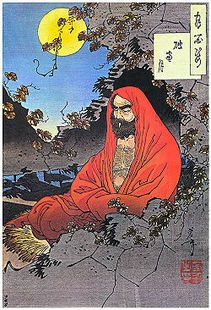 Bodhidharma “Something must be done!” he roared inwardly to himself and made his decision. He reached up and with each thumb and forefinger gripped the eyelids that had been failing him for the past seven years. As felt his bushy beard on his forearms and the soft flesh of his fingertips, he gave a merciless tug. The lids came off in his vice-like grip and he threw them to the ground, able to now continue with his meditation unhindered. Two years later, the Shaolin monks came to the cave to see if Bodhidharma still practiced there. They discovered no sign of the founder of the Zen lineage of Buddhism, except for two peculiar plants growing side by side on the ground near the wall of the cave. The leaves were a luscious green and their smooth curves were reminiscent of eyelids. These were the first tea plants. Or so the legends tell us! Bodhidharma’s eyelids (the tea leaves) were to be the fuel for generations of Chan (Chinese Zen) monks' meditation - helping them to stay awake during their practice. In actuality, tea has been around in China since at least the 10th century B.C., though it would take thousands of years before its commercial cultivation would find its way to Malaysia, the next stop on our world tour. After flying from Kolkata to Kuala Lumpur (we’ll blog about this city later, but FYI everything we'll do in Malaysia is on the eastern peninsula above, we didn't have time for the western part), Neda and I took the winding road up to the biggest hill station in the country – the Cameron Highlands. Developed in the 1930’s as a way for the British to escape the scorching lowland heat, an entrepreneur named J.A. Russell realized that it was also an ideal environment for growing tea. He bought a tract of land in the area and named his plantation Boh (Malaysian for “high”). Having missed the tea plantations in Darjeeling due to the cold weather there, Neda and I were excited to visit Boh and see the cultivation of one of our favorite beverages. 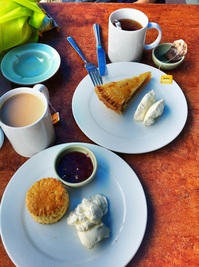 Our first day in Cameron, we met up with a Polish blueberry farmer turned off-season backpacker named Mat. He gave us some tips on a hike he had just done in the area and invited us to join him on a longer trek up to the tallest peak in the highlands, Gunung Brinchang. (Logistical Note: Mr. Yen in the Cameronian Inn gave Mat and us great tips on the hiking in the region and has drawn accurate and up to date maps as well). Our first trek, up to the top of Gunung Jasar, was presided over with blue skies and clear views of the village below as well as the cottage where Jim Thompson, the former CIA agent who helped revitalize the Thai silk business, was last seen before disappearing in these highlands one sunny day in 1967. The afternoon found us sampling the teas of the region while digging into homemade scones with strawberry jam and apple pie with a dollop of fresh cream. We felt quite aristocratic! 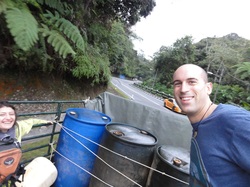 hitchhiking! The next day we set off early with Mat for our trek up Gunung Brinchang. The trek started from the next town over so we began the journey by hitchhiking on the back of a pick-up truck into town. This time around the sky was already darkening and droplets of rain foreshadowed the hike to come! But rather than detract from the experience, the weather added to it. The climb through the lush jungle as the rain splattered on the leaves was as atmospheric as it gets. Despite the mud and wetness, we were in high spirits as we emerged at the top, with a view only of the settled mist of the clouds we had entered as we climbed. Down a ways from the peak we walked on the more sterile boardwalk of the “mossy forest,” a tourist attraction that cleanly takes tourists through the views we had just seen but without the muddy shoes. Still, it made for some nice photos! 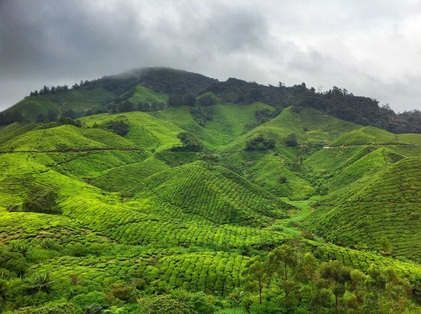 The road down the mountain led to the part of the trip Neda and I were anticipating the most. The tea! As we hitchhiked for the 2nd time down to the tea plantation, we admired the sprawling hills lined with the ordered plantings of the bright green tea. Finally, we arrived at the Boh visitor center, where after our long morning, the Palas Supreme whole leaf tea tasted just sublime. Neda swore it gave her a euphoric buzz, which the folks at Boh had long ago marketed when they said their tea had “uuummmph”! A walk through the tea processing plant also showed us how tea is picked, rolled to release its juices, oxidized (to turn it from green to black), and then dried for packaging. We left the plantation and after a short walk, took one last trip as hitchhikers back to Tanah Rata, the town where we started. 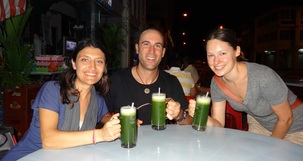 It was a successful trip up to the highlands and we enjoyed Mat’s company so much that we decided to go together to Ipoh, a nearby city that one of the guys who picked us up while hitchhiking lived in. He invited us there to show us some of the local cuisine. For this part of the adventure we added another traveler to our group, Kim from Seattle. Here's a picture of Kim and us with some fresh squeezed cucumber juice that looks sort of like a witches brew. Anyway, off we went to Ipoh to see what awaited! 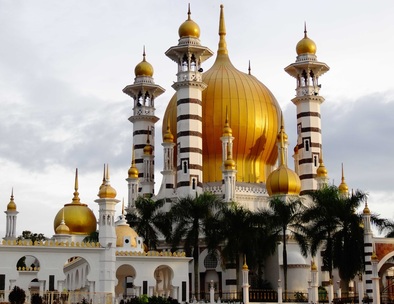 Well, it wasn’t exactly what we expected, that’s for sure. Our local contact never called us back, but that didn’t stop us from finding fun. First, we took a local bus out to the Malaysian Royal town of Kuala Kangsar, where we enjoyed the beautiful combination of British and Moorish architecture at Masjid Ubudiah (see right). That’s also where I got some delicious Nasi Lamak, a Malaysian dish of coconut rice with peanuts and a chicken leg in a sumptuous sauce. But once we arrived back in Ipoh, I was still hankering for the local dish of Ipoh sar hor fun (flat rice noodles cooked in chicken and prawn broth with chicken shreds, prawns and spring onions). It took us a bit out of the way to find it, but in doing so we stumbled upon a group of Indian Christians who were caroling in preparation for Christmas. Their Santa Claus had some sweet moves and a mean rhythm to accompany the tambourines and enthusiastically costumed kids. They even succeeded in getting Jeff into the action. You probably never expected to see a Buddhist-Jew dancing with an Indian Santa Claus while singing Christmas Carols, huh? See the video here! After a year full of adventures galore, we are approaching the end of 2012. Neda and I are going to head off to a Couchsurfing potluck in Panang in a few minutes to hang out with travelers from all over the world to celebrate Christmas Eve under the sweltering Malaysian heat! We wish you and yours all the best this holiday season and thank you for following along on our blog. Your comments and e-mails have been wonderful gifts to us all year long! Merry Christmas and a belated Happy Hanukkah! See all the pics of the Cameron Highlands, Ipoh, and Kuala Kangsar here!
http://flic.kr/s/aHsjDhnM3u 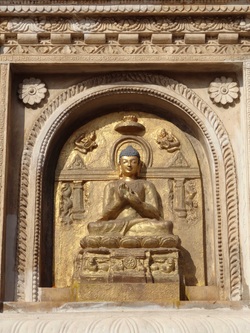 Bodhgaya is widely considered the most important place in the world for Buddhism. It is here that Siddhartha Gautama sat down under a Bodhi Tree with the intention of not rising until he had seen the truth about existence. In the Zen tradition, it is said that he sat for 7 days and nights, steadfastly returning to the moment despite the distractions that his ego continuously produced. Then, as the sun rose on the 8th day, he had an experience of pure insight. He sat slack jawed as the nature of existence unfurled around him. For the first time, he saw clearly how everything in this world is beautifully impermanent, interconnected, and dependent on each other. Enlivened with his newfound experiential knowledge, a smile of gratitude curled his lips upwards and the new Buddha rose and began his walk to Sarnath, where he would find his previous companions and give his first teachings (see previous post). 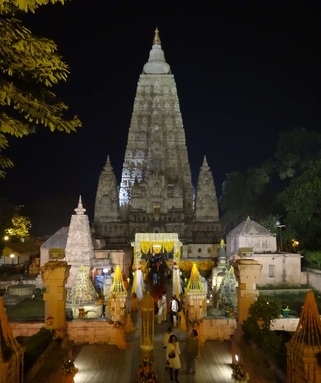 Mahabodhi Temple When we arrived in Bodhgaya, we were excited about two things. Firstly, the opportunity to sit and meditate under the Bodhi tree as millions of Buddhist pilgrims have done before. Secondly, we were excited to explore the plethora of monasteries that have been built in Bodhgaya, particularly the Japanese Nippon-Ji Temple, since our own practice of Zen lies within a Japanese lineage. Upon arriving and finding a guesthouse, we headed to the Mahabodhi Temple Complex our first night. The Mahabodhi Temple is a beautiful tower-like stupa next to the Bodhi Tree that was first built by the Buddhist Emperor Ashoka in the 2nd century B.C.E. It was beautifully illuminated, rising sharply into the evening sky with its intricate carvings of Buddha and other symbolic figures. Behind it lay rooted the enormous Bodhi tree, a direct descendant of the original tree, whose massive leafy branches snaked out from the trunk in all directions. Under the green canopy of the tree sat pilgrims in meditation and prayer. Neda and I joined them and I instantly felt a powerful heart opening energy as we settled into the space. In just a few minutes, a group of Thai monks joined the group and their teacher began a teaching on the basics of mindfulness and the eightfold path. How wonderful to sit in this special place and listen to the dharma with other Buddhists! 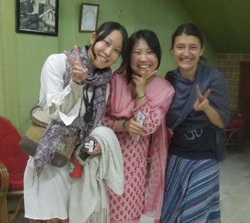 Riko, Rika, and Neda The next day, we headed off to find the Japanese Monastery, having seen a flyer at dinner the night before advertising that they were practicing the Rohatsu sesshin there. Rohatsu is one of the most important holidays in the Zen tradition, when monks and lay people meditate for 7 days and nights like the Buddha did in the lead-up to Dec. 8th, the day of awakening. We arrived at the temple on the morning of the 5th, and were enthusiastically greeted by Rika, a staff member for the Soto Zen Association of Japan. They still had space for us to join them and were ecstatic that we had some previous experience in the Soto lineage. Strange as it may sound, many of the Japanese young people who had joined for the sesshin had never practiced Zen before, leaving us more amongst the most knowledgeable people of the forms of Soto Zen! Rika, Roshi Ogasawla (the head teacher), and Osho Toha, a priest who had come to assist in the sesshin, welcomed us to stay at the temple for the next 3 nights while we practiced with them. 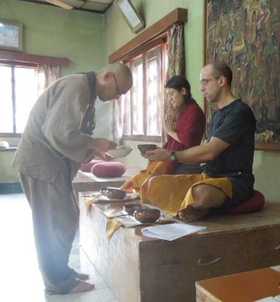 Toha Osho serving us during oryoki Words can’t describe how warm their welcome was and how relieved Neda and I felt to find a connection to our own tradition in the tumultuous sea of emotions that had been stirred up while being in India. We joined them that very afternoon, sitting zazen, eating oryoki-style meals (formal meals eaten in the zendo), and even bathing Japanese style (sitting on little wooden benches to soap oneself before immersing in a warm tub) in the monastery's communal bathroom! There are 3 jewels customarily spoken of in Buddhism. The first is the Buddha himself, or the aspiration each being has of shedding delusion and finding awakening. The second is dharma, or living in accordance with truth in order to find awakening - this is where the teachings come into play. The final jewel is sangha, or the community of like-minded practitioners who support each other’s practice. For us arriving at Nippon-ji and finding such a welcoming sangha that we could seamlessly join was one of the highlights of our whole trip in India. And it led to very deep meditation as well. As we sat on our cushions, I had a variety of insights which I will share in words here the best I can. While meditating for a long time, I found myself swaying between drowsiness and lethargy on the one hand and distracted thinking on the other. While this is perfectly normal, it occurred to me that both of these states are like bottlenecks on our ability to be open to the fullness of experience in a given moment. If one can manage to sit between these two states in open awareness, the flow of experience is so rich that it makes thinking and sleeping look like shadows of reality, only capturing very limited amounts of what consciousness is capable of. But how can we find this place in the middle? Only by returning to the moment, to the breath, over and over again with as much patience and self-kindness as we can muster. 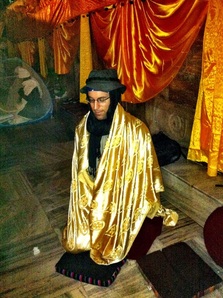 I also often thought of the Buddha and the great effort he must have put forth to find his own awakening under the tree. On the final night of the sesshin, our group moved from the monastery and did the meditation under the same Bodhi tree where the Buddha sat. As is traditional in the Soto lineage, you can choose to meditate for the whole evening of the final night as homage to the Buddha’s great effort. Neda and I decided to give it a try despite the swarming mosquitoes and dropping temperatures (see the picture of me bundled up with a blanket a fellow pilgrim gave me while under the tree to the left). After all, it was nothing compared to what the Buddha endured, right? Somehow the Buddha had settled his mind to the point that he saw interconnectedness not just as an analytical concept, but as reality itself. From this reality, he saw that as humans our best response to the enormous suffering in the world is to act from compassion and love in all that we do. In doing so, we free ourselves and we free others from the heavy burdens we all carry often without being aware of it. As the night passed, I felt tremendous gratitude not just to the sangha at Nippon-Ji who we had joined for this sesshin, but also for our community at the Missouri Zen Center and Austin Zen Center who have shared and supported this practice with us. I also felt a singular gratitude towards my incredible wife as she sat bundled up under the tree, her face set in deep concentration. Through our travels we have often only been a sangha of two, but two is a powerful number. In the end, the whole experience was like a spiritual booster shot. The warm smile of Osho Toha as he insisted on taking us to his favorite tent for black coffee and masala dosas, Rika’s invitation to come visit her in the mountains in Japan, and the camaraderie and friendship we found with Eric, Nari, Shin-shin, Shitoshi, Riko, and others who practiced with us. Since leaving Bodhgaya, we found our commitment to practice has been strengthened as we hold the three jewels close to our heart. Maybe we didn’t leave enlightened as the Buddha did, but certainly we felt lighter as we headed to our last stop in India, Kolkata. To see the rest of the pics of Bodhgaya click here. To see some pics of our time in Kolkata, exploring the remains of British colonialism at the Victoria Monument and Marble Palace while enjoying the relative calm of India’s only planned city, click here.
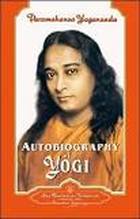 As my 32nd birthday approaches, I have reflected that Buddhism has now played a role in a full half of my life. It started at age 16, when a stressful residential summer school course led me to look for ways to vent the calculus infused steam from my head. At that time, in a little bookstore in Northfield Mount Hermon Massachusetts, I found a little book called “Yoga for Busy People” that would launch my interest in the spiritual life. Yoga asana helped me to find a bit of peace and eventually led to my interest in meditation when I was introduced to the book “Autobiography of a Yogi” by Parmahansa Yogananda at a little metaphysical bookstore that opened on my street while I had been away at school for the summer (strange coincidence that was – perhaps the universe really does offer what you need when you need it). 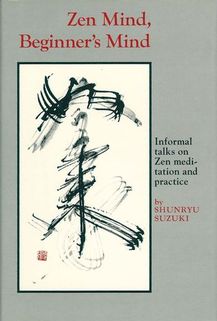 Later that summer I worked in my Dad’s epoxy factory and started talking about my experiences with yoga. Hearing my interest in meditation, the lead chemist at my Dad’s company (and later close family friend) gave me a book that would forever change my life. It was titled, “Zen Mind, Beginner’s Mind” and was written by a Japanese Monk, Shunryu Suzuki, who had come to America and found many Western students interested in learning the practice of Zen Buddhism. I read the book and found Zen meditation truly engaging, but for the next 3 years my focus was on Kundalini meditation as I received mailings from Yogananda’s group SRF (Self-Realization Fellowship) that taught different forms of pranayama (moving energy through the body with breath) for the purposes of opening the mind’s eye to the broader components of the universe. The various meditation practices instantly resonated with me. My previous interest in business management withered as I felt my heart opening to the suffering of people around me. Suddenly I found myself searching for philosophy books in the library and founding a meditation club in my high school for others with interest. 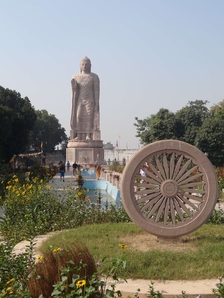 Thai Temple - Sarnath Yogic meditation is very colorful and the path is full of somewhat magical beliefs about the powers attained by yogis in the advanced stages of meditation. As a young person, it was all very exhilarating and at the age of 19, during my first summer after college, I headed out to the SRF monastery for 2 weeks to see if I might want to pursue the life of a monk. But there was a problem that my now philosophically minded viewpoint couldn’t overcome. Yogananda had died years before and to take him as my guru as SRF requested in order to move forward with the training, was a step I was unwilling to take. I hadn’t had any experiences that supported that Yogananda could guide me from the astral plane as the monks suggested. In fact, the whole thing just started to seem too strange and I left the monastery feeling discouraged because I wasn’t able to take the leap of faith required to continue with SRF. 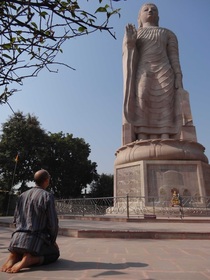 But Zen Buddhism was my life preserver in those choppy seas of self doubt. At that point, I had read Suzuki’s book hundreds of times and regularly practiced Zen along with my yogic practices. I realized that Zen offered me the compassionate and mindfulness based path that SRF had, but without the need for ascribing to beliefs of which I had had no direct experience. In fact, the Buddha always demanded that his students take nothing on faith, but always test his own words in the world of their experiences. This empirical and pragmatic approach was just what a disillusioned yogi needed. Zen became my primary spiritual practice and has stayed so until this day. Zen has been good to me. It brought me wonderful teachers and friends at the San Francisco, Missouri and Austin Zen Centers, and at the Great Sky Temple in Minnesota. It has led to a shared spiritual life with my wife, who immediately reverberated with a lifestyle of mindfulness and compassion when she meditated with me for the first time in St. Louis. It led to our adventure living in the Zen Center in Austin (AZC), Texas for a year, where we found a wonderful (living) teacher in the form of Seirin Barbara Kohn. At AZC, we learned the forms and traditions of Soto Zen and I took the jukai ceremony, sowing a ceremonial mini-robe (rokasu), taking the Buddhist precepts, and being given a Buddhist name by my teacher. Since leaving Austin on our world travel trip, we have left our community (sangha) behind and at times have struggled to maintain our practice with the diligence we had before. 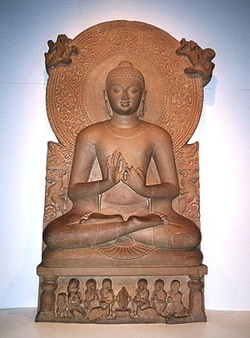 The Buddha giving his first teaching Within this context, we have been very excited about this part of our trip in India. In Varanasi, we explored a city of death, but just 10km outside of it lies an important place of Buddhist Pilgrimage – Sarnath. It is here that the Buddha first came after reaching enlightenment in Bodhgaya. He sought out 5 ascetics who he had practiced with previously to give his first talk, known in Pali as the Dhammacakkhapavathana Sutta. In a peaceful deer park amidst the chirping of birds and the grazing animals nearby, the Buddha told the ascetics of the 4 noble truths. Firstly, that suffering is a part of life. Secondly, that the cause of suffering is our false idea that we have a separate self that exists in isolation from the rest of the world. This fundamental delusion causes craving and attachment which leads to much suffering for ourselves and others. Thirdly, there is a way to see the nature of reality and our interconnection with it, thus ending suffering. Fourthly, this way incorporates ethics, mental training, and philosophy and is called the eight-fold path. The whole eight fold path is outside the bounds of this blog, but for more information it click the link above. When the Buddha finished his speech, it is said that the 5 ascetics, who had already undergone thorough spiritual training of their own, instantly saw the truth and were enlightened. Thus, this place is considered the birthplace of sangha, or the monastic spiritual community. Though in a more liberal sense, sangha has come to mean the community of all like-minded spiritual seekers who wish to support each other in the practice of seeing the true nature of reality and the compassion such a seeing engenders. Along with our new friend Eric from the previous post about Varanasi, we took an autorickshaw out to Sarnath and visited the Dhamekh Stupa, which is said to mark the location of the famous speech. We sat and meditated in the shade cast by the stupa as strings of devotees circumambulated around it while chanting in Thai, Burmese, Tibetan and other languages. Some women next to us brought their prayer boards, where they would sweep down in prostrations, extending their bodies out on the ground, before gracefully rising, lifting their hands in the air and repeating for hours at a time. The setting was peaceful and Neda and I felt the energy of the place was tangible as our minds were transported to 2,500 years ago when the Buddha brought forth a message that would influence our lives so deeply. 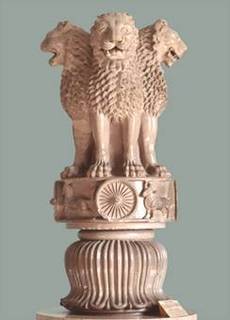 Ashoka Lions The area surrounding the stupa was once a great place of gathering for monks to come and study during the rainy season. Most of the ancient buildings of the libraries and monasteries here have been destroyed, their materials re-purposed for other buildings in Varanasi. But in the modern era, temples from the various nations practicing Buddhism have sprung up around Deer Park. We enjoyed the luxuriant decoration of the Thai Temple and chanted the service at the Japanese Nichiren temple to end the day. We also visited the archeological museum, which featured the Ashoka pillar topped with 4 snarling lions (facing in 4 directions to symbolize the teachings emanating out from Sarnath in all directions) that was placed at the site and has become the symbol of modern India. There is also a spectacular carving of the Buddha assuming the Dharmachakra Mudra, said to represent that first speech. For us, it was a wonderful experience to visit the site, made even more intimate by the presence of our friend Eric who practices in the Tibetan lineage. It really felt like we were making this pilgrimage together as a sangha of different traditions. But in the end, Sarnath would just be a taste of the community and spiritual focus that we would find in Bodhgaya, the place where the Buddha is said to have awakened to the truth. Read about that amazing experience in part 2 of this post! See the pics of Sarnath and some of Bodhgaya here: http://flic.kr/s/aHsjD7kk1j
The next part of our trip took us on a 30 hour journey to the holiest of cities in India – Varanasi. Due to trains being booked out for weeks, we were forced to take a local bus to Dehradun, during which an Indian woman threw up all over the seat right in front of us! That “1 hour” bus took about 2.5 hours as it idled away in traffic with the ubiquitous cacophony of honks desensitizing us. From Dehradun, a sleeper bus took us to Lucknow, where we finally were able to get a train to Varanasi. It is interesting that without any advanced planning, we arrived to the city right on my 32nd birthday! As drinking is pretty shunned here, after the long journey, we settled for celebrating in a small restaurant overlooking Assi Ghat, on the Ganga while our eyelids drooped with the exhaustion of the day’s travel. Ghats are a series of wide-steps that lead down to the river where pilgrims can bathe, wash their clothes, and offer prayer to the holy river. 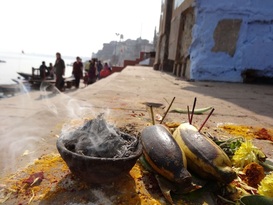 Beautiful offerings along the river In the end, Varanasi was actually one of our favorite cities in India so far; it is hard to explain, but there really is a certain energy in the city. Firstly, it is one of the world’s oldest continuously inhabited cities in the world (dating back to 1200 B.C.) and is one of the seven holy cities for Hindiusm. As Dadi Aum, owner of Aum Café in Varanasi told us, the city is dedicated to the worship of Shiva, the embodiment of creative destruction, masculinity (represented by many linga statues dotting the riverbank), and the act of renouncing worldly attachments. In this way, it is considered a particularly auspicious place to die because washing in the sacred river prior to death (or just after it) is believed to cleanse one’s attachments to the world, purify one’s karma, and lead to either moksha (liberation from the cycle of birth and death), or at least a more favorable re-birth in the next life. 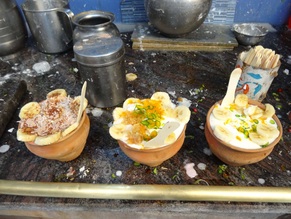 Mmmm...Lassis! In practice, this makes Varanasi essentially the world’s largest hospice, only minus the palliative care. A steady stream of elderly people travel there to take their last breaths and those whose lives ended prematurely are brought to Varanasi by their families to be washed in the river before being cremated on the steps of certain “burning ghats”. We would sit at the Blue Lassi, an extraordinary place serving up freshly frothed yogurt mixed with pomegranate and shredded apple in little clay cups, and watch a procession of bodies pass us by on their way to the river via the circuitous streets of the old city. They were carried at shoulder height or higher on wooden stretchers, wrapped in shiny orange and silver sheets, the entire stretcher wreathed with orange flowers. 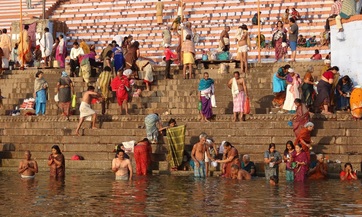 Pilgrims bathing and praying Exploring this riverside scene the day after my birthday was one of the most profound and dramatic days of my life. We met Eric, a fellow Buddhist hailing from Colorado, who joined us on the walk along the ghats. It was a beautiful morning and the ghats’ peaceful atmosphere was punctuated by the sight of the pilgrims washing themselves and singing out morning prayers. Everything changed, however, when we reached the main burning ghat, where rituals for the dead and cremation are performed in public. The energy of the area immediately changed and overwhelmed us with sadness, curiosity and contemplation. The buildings behind the ghat have a black hue from the constant stream of smoke arising from the square cremation pyres that rest on the river’s edge. Stacked wood rises several stories in the air, ready to be weighed and purchased by pilgrims wishing to cremate a loved one. The pyres sit burning on the river while within lie bodies in various states of incendiary transformation. In juxtaposition to the flame, we sat there frozen as we watched a family wash their son with the Ganga’s waters, removing bandages from bed sores, and then what appeared to be ghee (clarified butter) over his pale body. The two women involved seemed to be very stoic as they were preparing the body. After what felt like a very long time, they finally said their goodbyes and placed his body on a stack of wood and lit it. One of the women, we presume his mother, stumbled as she walked away from her burning son and nearly fainted, her face painted with a picture of utter grief that etched itself in our memories. I felt so many powerful emotions pooling together at that point - compassion for the pain laid out in front of us and an awareness of my own mortality nipping at my heels as I had just celebrated a birthday the day before. While the body was burning, in the background we watched as people tied bodies to heavy rocks and floated them out to the middle of the river to sink. Apparently some types of death (pregnant women, children, etc…) don’t call for burning, but for this ritual. On the other side of the ghat, body after body streamed down from the streets (from the spot I previously mentioned near Blue Lassi) was washed in the river, and then put on the cremation pyres. The visceral experience of watching the bodies vanish in the fires cannot be put into words, nor could my feelings as I watched the dogs circling around looking for remains to pick on. We couldn’t stay there any longer as the nauseating feeling became too strong, so we continued to explore the streets of the old city, at a loss of words. It seemed that in two days the whole cycle of life was thrusting itself into my awareness – the trauma of birth and the pain of death. 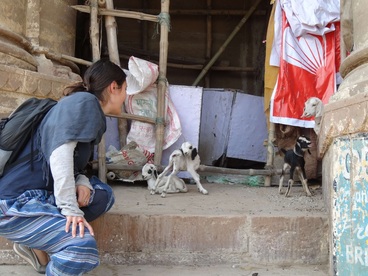 Playing with baby goats along Ganga But it didn’t just stop with the cremation ghats. Somehow it seemed the whole city was an embodiment of samsara (the cycle of birth and death). As we walked the streets, we saw a dead calf just laying in someone’s yard, while a chicken was picking on it. Dadi Aum told us that it’s not uncommon to see bulls lying dead in garbage heaps. They are not useful for their milk as females are, but the Hindu religion forbids their slaughter for meat. So instead they are just left to die, neglected and alone on the streets. We saw a litter of cute little puppies all huddled up together, some twitching and others still as they died from an unknown disease. But we also saw many mom doggies nursing their litters, baby lambs mewing out to us at every turn, and children playing innocently amidst the garbage littering the ghats (except for the kids who threw a piece of wood at Jeff’s head at night while walking back from the ghats – that wasn’t so innocent). If there is one thing we value about our spirituality, it is that it has given us a context to deal with these visceral extremes. We know that to close down to the pain we saw around us or to ignore the specter of death only leads to destructive behavior for us and others. But to open to the sobs of the women at the ghats, to move into the pain and the realities of samsara instead of cowering away, brings an equanimity that the Buddha encouraged us all to strive for. The city seems to be whispering “look, here is death laid out in front of you with no intermediary. This will happen to you. You can fear this truth or open to it. The choices you make will ripple through your life.” 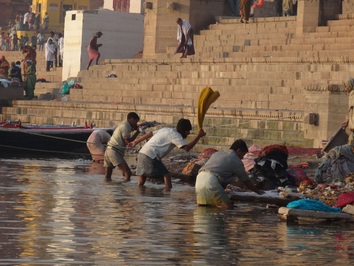 Laundry at the ghats of Ganga When Dadi Aum heard the call of the city, she sold her house in America and moved to Varanasi, becoming a Shiva devotee. She has rescued a bull she found dying in a trash heap and has tried to bring some dignity to the many who come here to die without the family or friends to help them through the process. For these elderly folks, the journey to Varanasi is meant to be their last one, but with no resources to their name, they just wander the streets, emaciated, weak, and waiting to die. Dadi Aum aspires to open a hospice-shelter to help these poor souls die with dignity – clean, dressed, and ready to open to source. It’s her way of trying to bring compassion to a place steeped in death. Perhaps it’s the secret of the city. If you can look past the veneer of cow dung littering the streets, men urinating around every corner, and 5 year olds carrying 2 year olds on their begging rounds, you can see the tremendous opportunity Varanasi offers a person who is working on the spiritual path. It offers the opportunity to tap into a current of human experience that is too often ignored by our Western society. It offers the opportunity to see the cycle of birth and death and find some peacefulness there instead of cold fear and rejection. For me, that was a birthday present that no material thing could match. This was indeed the most unusual birthday that will never be forgotten! After a quick and uneventful drive back to Delhi, we parted ways with our driver and caught the Shitabi Express train to Amritsar. The train was super comfy and we were served snacks, water, dinner, and dessert! Our travel agent had arranged for us to be picked up at the station, for which we were so thankful as the place was so full with people sleeping on the ground everywhere, that there was hardly anywhere to step on the floor. After sleeping in and resting, we started exploring the first of three religious practices we would encounter within just a few days. 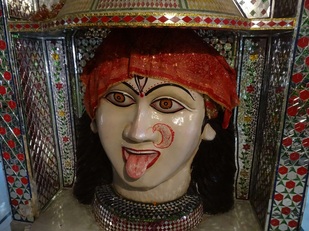 Mata Temple Statue Hinduism is the most common religion within India, though it covers many different practices throughout the country and is said to be more of a traditional way of life. It is also thought to be the oldest living religion as it draws its roots from the Vedic religion of Iron Age India. It is difficult to fully describe Hinduism within the scope of our blog because it is a conglomeration of multiple philosophical perspectives. But here are some core ideas. Hinduism generally sees the Godhead or Brahman, as represented by 3 personalities: Brahma (creator), Vishnu (preserver), and Shiva (destroyer). Some non-dualistic sects believe that the atman, or individual soul, is just an aspect of the Brahman and that the goal of practice is to realize this unity. Other dualistic schools see Brahaman as a separate being and believe that only by worshipping him in his various forms can freedom (moksha) be found. Most of the schools agree that humans are caught up in samsara (the continuing cycle of birth, life, death, and rebirth) and that through dharma (action in accordance with reality) people can find moksha. This dharma is represented by different yogas (paths or practices) like Bhakti Yoga (path of devotion), Karma Yoga (path of right action), Raja Yoga (path of meditation) and Jñāna Yoga (path of wisdom). Despite all this talk of freedom and unity, Hinduism has also incorporated into itself the socially rigid caste system. While barely addressed in key spiritual texts, the caste system has nevertheless become intertwined with Hinduism as it divides people into classes such as priest, warrior, merchant, laborer, or untouchable (outside of class). Our exploration of Hinduism in India continued in Amritsar with a visit to one of the most unusual temples we have encountered thus far – the Mata Temple. Dedicated to the female saint, Lal Devi, this Hindu temple’s design is a labyrinthine path taking you to your knees through fake caves and through ankle high water on other portions of the “temple route”. The whole thing is covered in mirrors and colored glass as you pass by imagery of various devas like Shiva, Ganesh, black Bhuddas and even a saint with three breasts that reminded us of Total Recall! The experience here was more akin to a fun house than a place of worship, but at the end, we were mesmerized by the beautiful singing chants of the ladies in the main temple hall. We sat here listening quietly to their devotional calls and reflected on our experience here and in India, which is truly like a game of roulette in a casino. You never know what to expect here – one day, you are inspired by the devotion and spiritual dedication of the people and the next you are shaking your head as they blatantly lie to you about travel while you cover your ears to protect them from the constant honking and noise found on the streets. The next stop in our day was the heart of Amritsar, the Golden Temple, which is also the heart of the Sikh religion. This monotheistic belief system was founded in the 15th century in the Punjab region of India and this state remains largely populated by Sikh believers. In some ways Sikhism is easiest to define in its differences from Hinduism. It rejects the caste system and encourages nondiscrimination based on caste, creed, or gender. It encourages people to live lives as householders and not idealize the idea of the renunciant yogi who leaves all attachments to go find truth in the wilderness. To the Sikhs, God is present in everything and by meditation and right living one can break through maya (the false human view of reality) to find union with him. 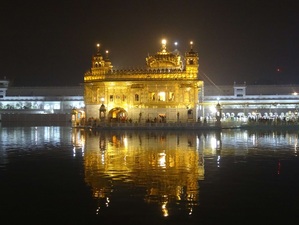 The Golden Temple is the biggest pilgrimage site for the Sikhs and every Sikh is expected to volunteer here for at least one week during their lifetime. The light shines brightly off of its gilded copper plates, all of which are situated in the middle of the sacred “pool of nectar”. Its dome represents an inverted lotus flower and gilding it took 750kg of gold! All day long, priests inside the temple recite chants from the holy book and loud speakers broadcast this throughout the complex. The most interesting experience was dining here. To honor their belief of the equality of all people, the Sikhs provide a free meal for all visitors. We lined up with the crowd and were continuously stared at unabashedly by the older Sikh men as there were not many ‘white’ visitors lining up to eat here. As usual, there were several people trying to get ahead in front of everyone by just pushing their way through. We found it terribly ironic that even in their most holy temple the Sikh people would be so impatient as to push ahead of others when there was plenty of space for everyone to eat. Once the hall cleared out from the previous group, it was our group’s turn to enter and the crowd swelled at the entrance of the double doors as people pushed and shoved to enter the empty hall and find a place on the ground. Once breathlessly seated, servers came by with buckets and served everyone a ladle or two of different kinds of dal, some type of curd, and roti. Sometimes it seems that regardless of religion, the booming population in India has made everyone act like dogs fighting over the last bone. We did find that the Golden Temple was much less hectic at night and enjoyed walking around the pool of Nectar to the soft sounds of chanting over the speaker. The city of Amritsar was a bit stressful so we decided to head to Dharamsala a bit earlier to breathe some clean air in the mountains and get ready to see the Dalai Lama! Dharamsala rose to fame in 1959 when it became the home of the Tibetan government in exile and the 14th Dalai Lama. We found out he was teaching during our visit to India, so we decided to go up North before it gets too cold to see him. This brought us to our third religious encounter – Tibetan Buddhism. As opposed to our practice of Zen, which founder Bodhidarma espoused to be “a special transmission outside the scriptures, not relying on words and letters,” Tibetan Buddhism appears to emphasize the oral transmission of teachings and utilizing these teachings in analytic meditation. Tibetan Buddhists are encouraged to engage in internal debate over the oral teachings and alternate between this analytic meditation and calm abiding meditation. Another major difference in Tibetan Buddhism is the use of Tantric (Vajrayana) practices to attain enlightenment in a single lifetime. 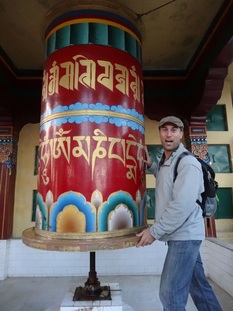 Spinning the huge prayer wheel The Tantric practices are not shared with uninitiated disciples, which has to be done by a qualified lama. While we don’t necessarily connect with these aspects of the religion, it is a very colorful form of Buddhism with beautiful mandalas, prayer wheels, and chanting seen and heard all over the temple. While in Dharmsala we enjoyed circumambulating around the temple at sunset, with amazing views of the Himalayas in the background and Tibetan prayer flags in the foreground. We took a day trip to the nearby Bagsu Waterfall and drank delicious lemon-ginger-honey tea at the Shiva café while the young backpackers next to us chatted nosily in a ganja induced state. We enjoyed looking at the wonderful crafts the Tibetan refugees had crafted like turquoise covered prayer wheels filled with thousands of repetitions of the compassion mantra or the delicate Thangka paintings, which are sacred mandalas painted onto cotton. 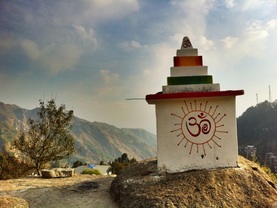 Beautiful stuppas on the hills above Dharamsala The whole process of preparing for the teaching ended up offering a bit of a laugh in the end. We spent one morning registering for it and next day arriving early to pick out our seats for following day’s teaching. Then, on the morning of the teaching we arrived two hours early to wait. The Dali Lama entered the building and settled down on his seat and began to teach. It was then we discovered that the FM broadcast of his teaching in English didn’t work on the side of the temple we were on! We eventually moved, but still the translation wasn’t great and the teachings on the Lam Rim text proved too convoluted to capture our interest. But the experience of seeing the famous leader and teacher alone was interesting. He is smaller than I had thought but quite jolly as he appears on many photos. He likes to make some jokes while lecturing and is quite animated using many hand gestures when he teaches. At one point during his exit, we were so close to him that we could touch him (but we are pretty sure the guys with the big guns would not have been happy J!). He always tried to embrace people as he entered and left the temple and his presence inspired smiles and happiness. After a relaxing time in Dharamsala, we took an overnight bus to Rishikesh, the self-proclaimed yoga capital of the world. More accurately we came 2km north of the town of Rishikesh to where the ashrams and yoga centers are – an area called Swarg Ashram and Lakshman Jhula. The area is littered with posters advertising many different yoga centers and teacher trainings for Westerners. We have attended some classes and looked into staying at some of the ashrams, but in truth all the classes just left us really missing our teachers in Austin. Teachers here are prone to make rough adjustments that can easily lead to injury, don’t properly warm-up students, and teach sequences of postures that are generally less creative than what we found in Texas, strange as that sounds. What was once a relatively isolated place of pilgrimage for Indians looking to meditate on the sacred Ganges has become a cluster of guesthouses and restaurants, all with multi-national menus serving white folks. That’s not to say that there aren’t Indians here. The area is crowded with pilgrims and this combined with the yoga seekers has led to an overdevelopment that leaves the streets congested with honking taxis and motorbikes, leaving one’s ears buzzing after just a few minutes in the street. Despite all of this, it can’t offset the beauty of the Ganga at sunset or of the river itself. 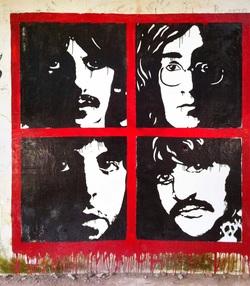 One interesting bit of history lying in ruin in the forest near Swarg Ashram is the enormous ashram of Maharishi Mahesh Yogi, the founder of Transcendental Meditation (TM). The self-proclaimed Maharishi (enlightened one) hosted the Beatles at this ashram in 1968, where they are said to have written parts of the White Album. But their stay was somewhat short-lived amid accusations of sex-scandals and profiteering by the Maharishi. TM has continued as a money making force however, and when the Maharishi died in 2008, his estate is said to be worth anywhere from 600million to nearly 2billion dollars. The ashram lost its lease on the land in 1997 and has since yielded to the forest, making for a fascinating walk through what was once a hippie style wonderland. There are hundreds of little round capsules where devotees could live on the bottom and perform meditation at the top. The complex includes many deteriorating dormitory style buildings as well as a large auditorium (since made into a shrine for the Beatles – see pic above) and the Maharishi’s old home. This is one of our longer posts and as you can see, it is full of mixed emotions. What spiritual perspective have we been taking on this whole experience? On the one hand, the constant strain of being out in public in India has taken a toll on me as a woman. When it’s not the aforementioned noise, it’s the leering looks of the men as you walk by and the occasional grope that they try to pretend was a stumble. Combine that with the dirtiness of the place and it makes me just want to get out of here. But Jeff and I have reflected that in some ways the whole place is like a container in which you are uncomfortable to be and the only way to find peace is to accept the situation, not fight against it. In such places, you must confront your ego and either work towards loosening its grip on your outlook or find yourself in even more pain. Maybe that is why India is the heart of so many powerful spiritual practices while simultaneously being such a trying place to travel within!
The pics from these three towns are on flickr - http://flic.kr/s/aHsjD17oST. |